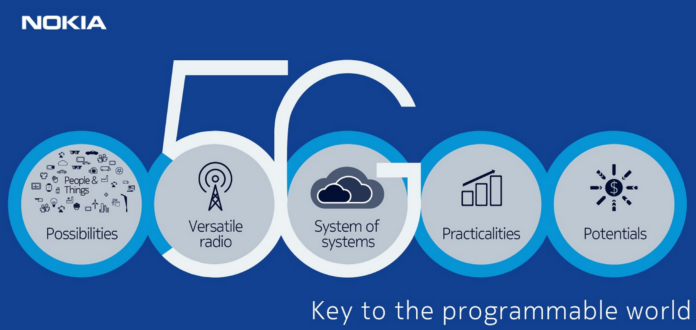Nokia Networks executives stressed during Mobile World Congress last week that “5G” isn’t just marketing hype, but rather that innovative new use cases and commercialization may be here sooner than the industry thinks.
Although still prestandardized, 5G trials and partnerships are developing in earnest. RCR Wireless News caught up with Volker Held, head of innovation marketing for Nokia Networks, to get his take on the 5G outlook.
Held pointed to Nokia’s AirScale radio access technology, which the vendor said delivers throughput in excess of 20 gigabits per second.
“This is not only a marketing claim,” Held said. “We are using it. It’s really prestandard 5G. I would say, overall, the tracking [for commercialization] is good. We have a good concept of the industry and the technologies and what it can deliver.”
During Mobile World Congress, Nokia CEO Rajeev Suri said the company expects initial 5G deployments before 2020.
“2020 is probably where we see global volume deployments, but we will start to see a lot of action ahead of 2020 – in 2017, 2018, 2019,” Suri said. “5G will happen faster than expected.”
Verizon Communications has started 5G field tests with Nokia Networks, testing prestandards technology in Verizon’s live network in the Dallas-Fort Worth, Texas, area. Verizon and Nokia said they tested an “extreme broadband” use case to look at the viability of replacing high-speed, indoor wireline connections with wireless, examining outdoor-to-indoor penetration in a residential apartment. The two companies also tested a 5G latency use case, with the technology expected to support ultralow latency.
Nokia said it used its precommercial radio system running in the 73 GHz and 28 GHz bands to provide fixed wireless broadband, with the links producing speeds of “multiple [gigabits per second] in a real environment with a spectral bandwidth of 1 gigahertz and [approximately 1 millisecond] one-way air interface latency.”
Held said autonomous vehicles would be a major 5G use case.
“I think one key area is the autonomous steering of machines,” which contemplates not just steering but automatic synchronization. “Machines have to synchronize themselves,” Held said. “All the cars as a whole behave in an optimal way. What you can see there is that all cars are connected and they’re completely steered by the network. If you were then a person you could just sit down, relax and do nothing.”
Held added the advances around 5G, as compared to the same time last year, have been “incredible. From the technology perspective I do not see big constraints. It’s just a matter of details. The challenge is more to make all these new use cases happen. The challenge is more of a business challenge at the end of the day. Mobile operators are not used to deal with production people inside an industry. They need to talk to each other. It’s a business challenge; not a technology challenge. The technology is pretty far advanced.”

